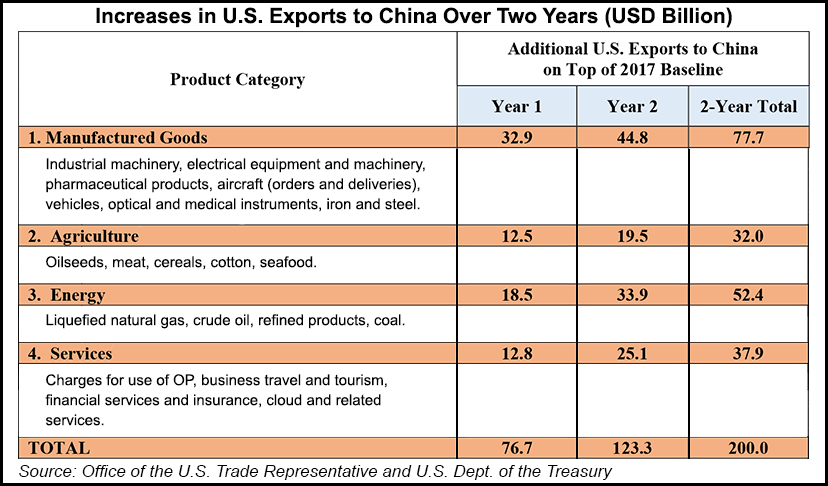Regulatory | LNG | LNG Insight | Markets | NGI All News Access | NGI The Weekly Gas Market Report
U.S.-China Trade Deal Seen Having Minimal Impact on LNG Exports For Now
The agreement signed by President Trump this week to ease trade tensions with China provided little assurance that growing U.S. liquefied natural gas (LNG) exports will have a stronger role to play in one of the world’s largest import markets.

While the deal was seen as an important step to restoring trade relations and paving the way for more energy exports given China’s pledge to buy $200 billion of American goods over the next two years, the first phase agreement removed no tariffs imposed by the countries.
Of the $200 billion in goods China has committed to buy, $52.4 billion are energy products, including LNG, crude oil, refined products and coal. But China’s 25% tariff on imports of U.S. LNG and its 5% tariff on imports of U.S. crude oil remain in place. The tariffs could eventually be dropped if ongoing talks produce a second phase agreement, Trump said Wednesday.
“For China to massively increase imports of oil and LNG from the U.S. while tariffs remain in place is going to be challenging,” said Wood Mackenzie’s Gavin Thompson, Asia Pacific vice chairman.
While China is the world’s largest importer of crude oil, U.S. exports to the country have fallen over the last year. U.S. LNG imports have dropped as well, but much of China’s oil comes from the Middle East. China is the world’s second largest LNG importer behind Japan, and purchases of the super-chilled fuel there are expected to grow as U.S. LNG volumes are forecast to increase significantly in the coming years.
The country was once a top destination for U.S. LNG exports, with about 65 cargoes shipped there since 2016, when exports started. But China has retaliated with tariffs, including those on oil and LNG, since the trade war began two years ago when Trump followed through on a plan to counter what he saw as unfair trade practices. The trade clash has hindered U.S. exports, particularly LNG. Just two U.S. cargoes have departed for China since early last year.
If China can execute on its pledge, “it can deliver a much needed respite to U.S. LNG exporters,” said Bloomberg New Energy Finance analyst Daniela Li in a note on Thursday. But while the U.S. is forecast to become the second largest supplier to China in 2021, U.S. offtakers “face demanding buyers in an oversupplied global LNG market,” she added.
ClipperData’s Kaleem Asghar, director of LNG analytics, told NGI that the first phase agreement lacks clarity when it comes to natural gas. He noted that the world is awash in LNG and said China regularly receives supply from Pacific and Persian Gulf countries.
“So first, the 25% tariff needs to go, and even then, it’s a huge challenge to displace Australian and Qatari volumes,” he said. “I think there is going to be a big price war if the U.S. wants to seal its volume to China.”
If the tariffs remain in place and China does increase U.S. LNG imports under the agreement, those fees would likely be absorbed by importing companies or passed through to consumers, according to Wood Mackenzie.
“We expect that Chinese national oil companies will be reluctant to commit to large-scale purchases given this,” Thompson said. “At the same time, the next two years will also see a slower pace of gas demand growth in China, rising domestic production and the arrival of Russian pipeline gas, creating a more competitive gas market.”
Even still, uncontracted LNG demand in China is estimated to be 17 million metric tons (mmt) this year and 23 mmt in 2021, a chunk of the global market that U.S. exporters will no doubt target, the firm said.
At the very least, the first phase agreement has de-escalated a trade war that has roiled the global economy. What comes next is likely to be even more essential.
“While the market will be digesting the agreement in coming days, the debate will move towards the ability to build upon it in subsequent negotiations; the willingness and ability of China to implement the promised reforms; and the impact of the upcoming election on U.S.-China relations,” analysts at Raymond James & Associates Inc. said in a note on Thursday.
© 2024 Natural Gas Intelligence. All rights reserved.
ISSN © 1532-1231 | ISSN © 2577-9877 | ISSN © 1532-1266 |
